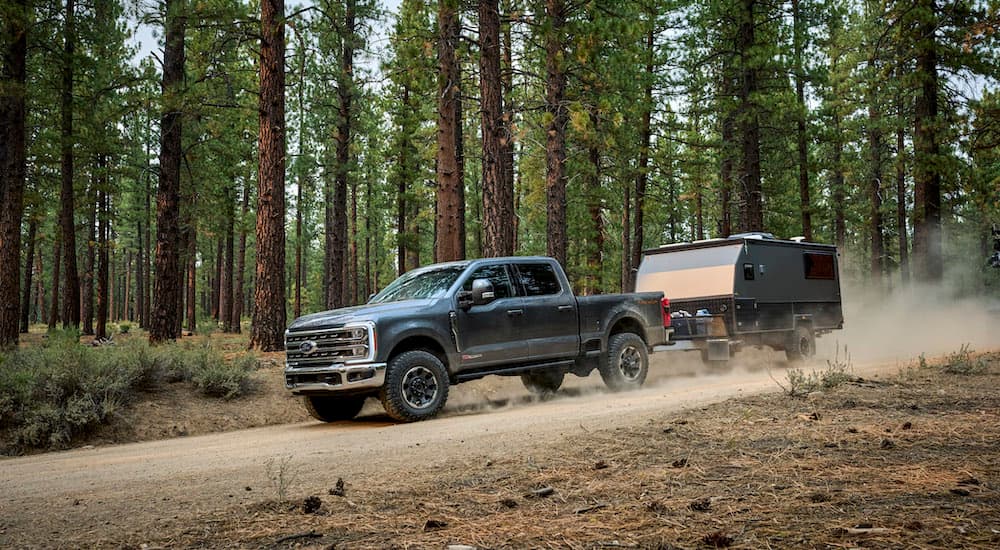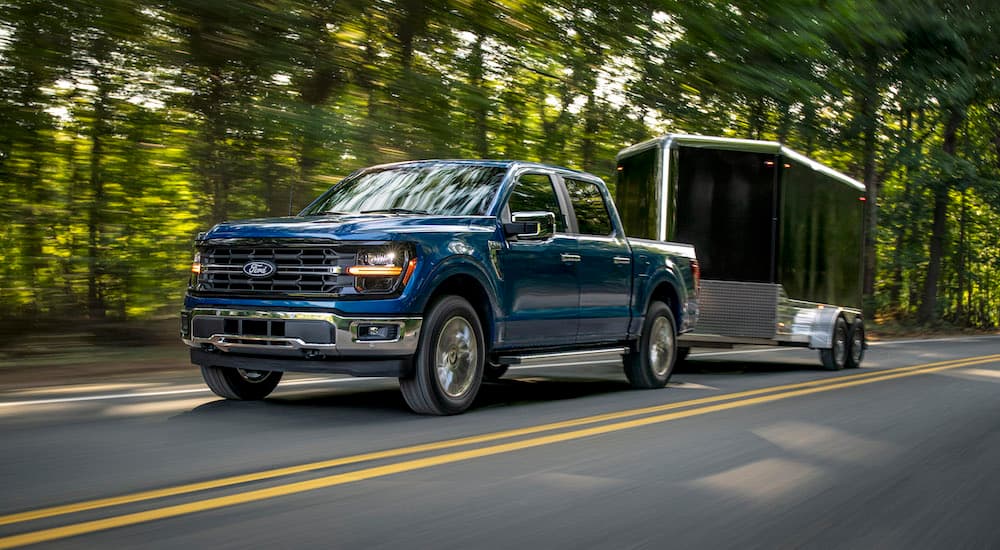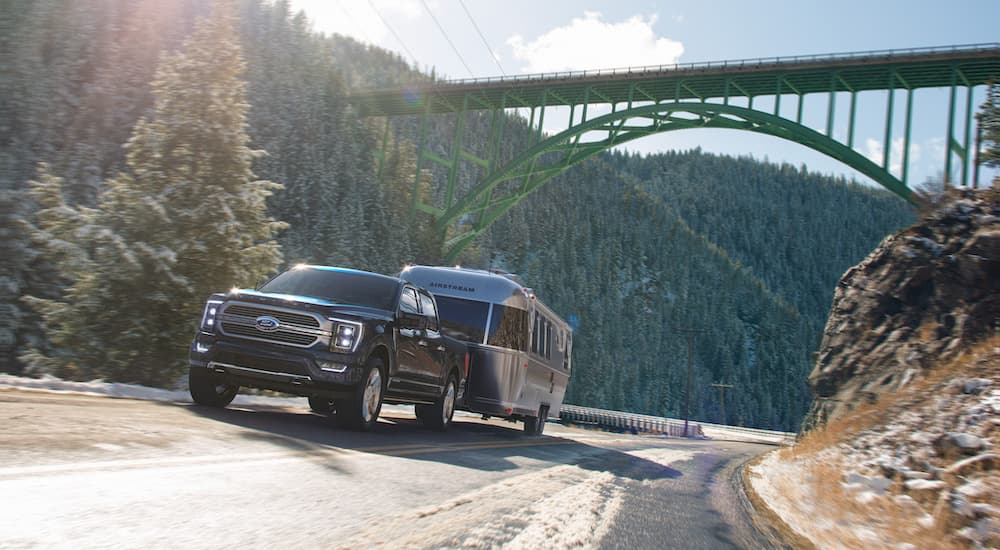I spent several years driving a full-size truck with a double-stack trailer loaded with rescue boats in tow, navigating major highways across the United States and congested city streets that forced a white-knuckled grip. Trailering a rig that size wasn’t for the faint of heart and was nerve-inducing, especially considering the best technology available was a backup camera and a kind spotter. Today, the story is much different at Ford dealers nationwide because trucks like the Maverick, Ranger, Lightning, and F-150 are outfitted with cutting-edge towing technologies that simplify the process and instill confidence in every condition.
Ford’s trailering technology is a cut above the rest, giving its truck lineup a significant advantage over rivals. But what does this technology do for your experience in the driver’s seat? Does it genuinely simplify towing and everything involved in the trailering process? Now, as the proud owner of an F-150, I can confidently say it does, and here’s how.
#1 – Hitching Up: Pro Trailer Hitch Assist
The first step in successfully towing a trailer starts with safely hitching it to your truck. Even this feat can be challenging, especially if you don’t have another person to spot you or a quality rearview camera that gives you a clear view behind the truck relative to the trailer. Ford offers a solution with its Pro Trailer Hitch Assist technology. By pushing and holding the Pro Trailer Hitch Assist button, your Ford truck will take over the process by steering, braking, and accelerating to align itself with the trailer. There’s no need to leave the cab to check the distance because the tool does the hard work for you.
#2 – Towing Safely: Onboard Scales With Smart Hitch
Before you’re hitched up to the trailer, it’s critical to determine if the load is safe or within your truck’s towing capacity. While this is often a best-guess scenario for seasoned drivers, Ford eliminates the guesswork with its Onboard Scales with Smart Hitch technology. Smart Hitch works with Onboard Scales by measuring the weight of the load on the tongue as you lower the trailer into place. This measurement is shown in the SYNC 4 infotainment system using the Onboard Scales technology. The system gives you insight into the trailer’s load and how it’s balanced, guaranteeing you know how much you’re carrying and that it’s well within your truck’s ability.

#3 – Watching Your Blind Spots: Blind Spot Information System With Trailer Tow Coverage
One of the most stressful aspects of towing a trailer is changing lanes in a sea of traffic. There’s always the question of if there’s another vehicle in your blind spots or if the cars behind you are traveling too fast to accommodate your truck and trailer as you change lanes and pull in front of them. Ford’s Blind Spot Information System instills confidence by adding Trailer Tow Coverage. The technology minimizes the anxiety of changing lanes by monitoring the blind spots on the sides of the truck and trailer. If the tool detects a vehicle in any of your rig’s blindspots, it alerts you to help you safely change lanes.
#4 – Expansive Views: Turn Signal Camera View With Trailer Coverage
Visibility and situational awareness are critical when towing a trailer, making tools like the Blind Spot Information System with Trailer Tow Coverage integral to your safety. However, Ford doesn’t stop there and extends this visibility and situational awareness by using its expansive camera system. Trucks like the Super Duty models typically feature a Turn Signal Camera View with Trailer Coverage. As you activate the turn signal to change lanes, the technology uses the truck’s center touchscreen display to show you a clear view along the side of the truck and trailer. This gives you another view of your surroundings and complements the integrated trailer coverage with the Blind Spot Information System.
#5 – Navigating in Reverse: Pro Trailer Backup Assist
Even though I was confident navigating the road with a double-stack boat trailer in tow, that confidence dramatically lessened when it was time to maneuver the rig in reverse. Whether you’re a seasoned pro at trailering or are honing your skills, there’s no doubt that driving a truck and trailer in reverse and getting it perfectly positioned the first time can feel impossible. Ford’s Pro Trailer Backup Assist lessens the learning curve by making the process as simple as turning a knob on the dashboard.
Ford trucks with Pro Trailer Backup Assist rely on the truck’s camera system and expansive center touchscreen display. Once you activate the technology, you can turn the knob to maneuver the trailer where you want it. You can see that movement on the touchscreen display, with the technology expertly guiding the trailer and truck into position without having to shift gears out of Reverse into Drive, realign the entire rig, and try again.
#6 – Finding the Best Route: Trailer Navigation
From experience, I can confirm that navigating a truck and trailer through rush-hour traffic in one of the biggest cities in the country isn’t ideal, especially when there’s construction on the road. Tools like Ford’s Trailer Navigation are designed to prevent these situations and help you navigate the road confidently. The available technology recognizes that you’re towing a trailer and considers the trailer’s size (height and length) to determine the best route, avoiding narrow streets, tight and steep corners, and low bridges with minimal clearance.
#7 – Stay Informed: Smart Trailer Tow Connector
Ford’s Smart Trailer Tow Connector is another integral tool that keeps you informed as you navigate the road with a trailer. During your pre-departure checklist, you likely checked the trailer’s lights, ensuring the turn signals and brake lights work correctly. From there, you rely on the initial check that everything’s in operating order until your next stop or another driver alerts you to an issue.
With Smart Trailer Tow Connector, you don’t have to “tow blind.” The available technology monitors your trailer’s lights and battery as you drive. If it senses something is wrong, like the turn signal lamps aren’t working or there are issues with the battery, you’ll see a notification in the digital driver dashboard. With immediate feedback from the technology, you can pull over and resolve the issue to ensure safe towing.
#8 – Maintaining Control and Enjoying the Ride: Continuous Controlled Damping
We often expect trucks to handle rough because of their size, especially when towing a trailer. However, automakers like Ford prove this is no longer the case and that even a truck towing a trailer can deliver a smooth ride and help keep you in control. Trucks like the F-150 feature an automatic adaptive suspension with continuously controlled damping. But what does this do?
The system continuously gathers data about the truck’s suspension, speed, steering input, and the load it’s towing. As it gathers this information, it’s also evaluating the road conditions. This information tells the system how to adjust the stiffness of the shock absorbers, improving your control over the truck and its ride quality.
#9 – Best-in-Class Capability: Ford’s Potent Powertrains
Ford’s trailering technologies wouldn’t mean as much without the potent powertrains that make up the automaker’s truck lineup. Ford is renowned for building reliable workhorses like the Ranger, Maverick, Lightning, F-150, and Super Duty. The trucks have exceptional work ethics and brute strength, courtesy of their engaging powertrains that include everything from the 3.5L PowerBoost Full Hybrid V6 to the tried and true 3.5L EcoBoost V6. The options are plentiful, with Ford offering best-in-class payload and towing capacities that allow its cutting-edge trailering technologies plenty of opportunities to shine.





